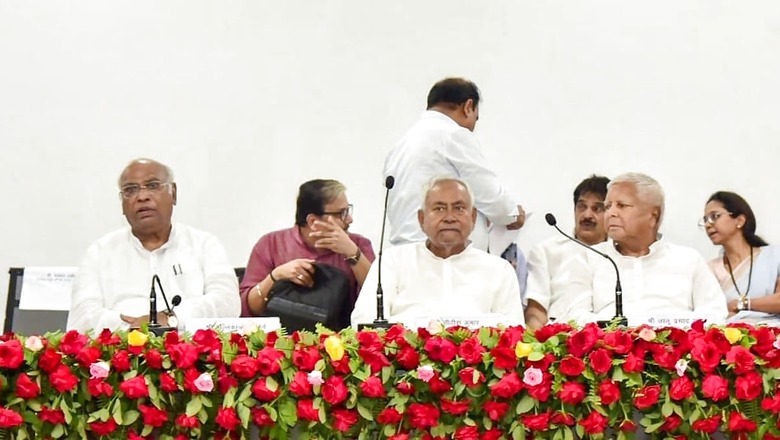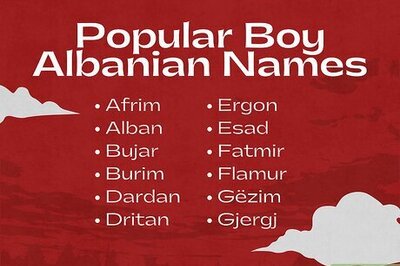Census & Sensibility: Bihar Caste Survey Boosts Nitish's Position Without Hurting Any Party, for Now

views
The release of the first-of-its-kind caste survey findings in Bihar has set the political tone in the state, and its broader impact will soon be felt on a national scale as well. While the survey report still lacks clarity on several issues, it highlights the numerical dominance and electoral influence of OBCs in the state in no uncertain terms. This is also seen as a boost to chief minister Nitish Kumar’s political stature both inside and outside Bihar.
Buoyed by the potential electoral implications of the survey results, the CM posted on social media that his government would soon convene a meeting with the nine parties in the Bihar assembly to discuss the findings.
The electoral significance of these findings has triggered a race among political parties to claim credit for the survey. Nitish’s ally and the largest political party in the state, the Rashtriya Janata Dal, has asserted its role, along with the Congress, and even the opposition BJP in the state.
However, upon closer scrutiny of the survey numbers, it becomes evident that the biggest political gains will be enjoyed by CM Nitish Kumar. Hailing from the Kurmi caste, which constitutes just around 2.87% of the state’s population, according to the survey, Kumar has been basing his politics on what political scientists term, a ‘tripod’.
The first pillar of this strategy involved garnering support from the Extremely Backward Classes (EBCs), a term used to collectively denote numerous smaller and scattered backward castes in the state. The survey has now found that the EBCs, constituting 36.01% of the population, are the largest social segment in the state, followed by the Other Backward Classes at 27.13%.
The second caste grouping that Nitish innovated was the concept of Mahadalits, which refers to the poorest social groups within the Scheduled Castes (SC). The survey has found that 19.7% of those counted belong to the SC community, a number significantly higher than the 2011 census count of 15.91%.
However, besides Nitish’s JD(U), the Lok Jan Shakti Party of the late Ram Vilas Paswan’s clan and former Bihar CM Jitan Ram Manjhi’s Hindustani Awam Morcha (HAM) also claim a significant share of the Dalit votes in the state. Paswan’s party lays claim to Dusadh votes, while Manjhi’s support comes from the Mushar community.
The results of the new survey though may prompt Nitish’s opponents to question whether he can retain the position of CM, considering that he hails from the Kurmi caste, which comprises only 2.87% of the population. In contrast, the Koeris, with a 4.21% share of the population, have two prominent leaders: Samrat Chaudhary, the BJP state president, and Upendra Kushawaha of the Rashtriya Lok Janata Dal, who was once a friend but is now a foe of Nitish.
Lastly, Kumar relied on the Kurmi-Koeri or ‘Luv-Kush’ caste matrix, although not in the same order.
The survey outcome will also elevate Nitish Kumar’s standing within the INDIA bloc, where, despite being the first mover in alliance formation, he has recently been sidelined. Additionally, it will alleviate the pressure on the Bihar CM, as some insiders have suggested that the RJD, his ally, was pressuring him to pursue a “larger” national role, which could have meant leaving the state to the Tejashwi Yadav-led party.
The accomplished survey could also smoothen Nitish’s journey and bolster his negotiating strength, should he choose to rejoin the BJP-led NDA camp.
It will further intensify competition among opposition parties as they strive to reach out to backward castes and secure their votes.
For the RJD, having a definitive count of both its core Muslim and Yadav voters is significant. The number of Yadavs in the state, previously estimated to be between 9% and 12%, has now emerged as the largest caste group with over 14% headcount, constituting over 50% of the Backward Caste population (27.12%).
Additionally, the proportion of Muslims in the state’s population has risen from 16.86% in the 2011 census to 17.70%.
Despite the expansion of its core voter base, the RJD could face challenges in maintaining power and influence in state politics, particularly in the race for the chief minister’s post. This is because the politics of the Extremely Backward Classes may overshadow the politics of the Backward Castes, which has been the focus of Lalu Prasad Yadav’s efforts for years.
In addition, the aggressive number posturing by the Yadav leadership may further alienate the EBCs from the RJD, as there could be a rise in anti-Yadav polarisation, as both groups are not seen as socially compatible on the ground.
The Yadavs, alongside the Kurmis and Koeris, who have been the primary beneficiaries of government schemes and reservations, might now need to share resources and power more equitably with the EBCs.
The Muslims, who have so far largely followed the Yadav leadership within the RJD, may start seeking better representation both within the party’s leadership and in positions of power.
The increase in the share of Scheduled Castes, rising by 3.79% to 19.7% compared to the 2011 census, is likely to further bolster the ambitions of Dalit leaders in the state. Dusadhs, who constitute the core vote bank of the Paswan clan, along with Dhari and Darahi communities, account for 5.31% of the state’s population. Meanwhile, Mushars, the electoral backbone of Manjhi’s HAM, make up 3.08% of the total population, according to the survey. Leaders like Manjhi may leverage these numbers to negotiate for more seats from the BJP in the upcoming Lok Sabha polls.
For the BJP, the findings of the survey do not pose a concern. With Prime Minister Narendra Modi, who is himself an OBC, leading the party, it would not be easy for the opposition to level charges of the BJP being anti-OBC. The BJP’s Bihar state president, Samrat Chaudhary, also comes from the EBC grouping. Central schemes, like the recently launched PM Vishwakarma, are specifically targeted at the politically non-dominant but numerically superior EBCs.
Furthermore, the survey findings have also laid the groundwork for the BJP-led Centre, in case it decides to implement the recommendations of the Justice Rohini Commission. Although the report of the commission, which was established for the sub-categorisation of Other Backward Classes and fair distribution of benefits among the groups, has not yet been made public, experts believe that this could potentially be a game-changer for the saffron party.
The general category, or the “upper castes”, constituting 15.52% of the population, is in line with expectations. However, with the continued focus on appeasement of OBCs and EBCs, this group may further lean towards the BJP.
At the national level, the survey will intensify competition among opposition parties as they vie for a share of the OBC vote. Congress MP Rahul Gandhi has already praised the survey, while the Aam Aadmi Party’s Sanjay Singh has reportedly called for a nationwide caste census.
In the coming weeks, this issue will dominate the political discourse until another political party makes a bigger, bolder, and better move related to the OBCs.


















Comments
0 comment